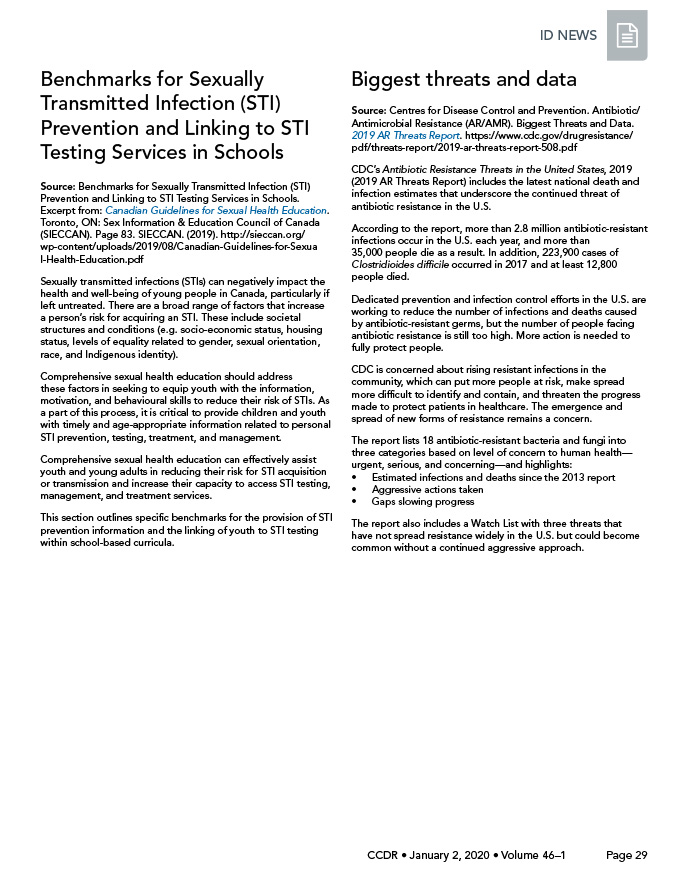Testing for Sexually Transmitted Infections in schools; CDC Report

 Download this article as a PDF
Download this article as a PDFPublished by: The Public Health Agency of Canada
Issue: Volume 46–1: Antimicrobial resistance (AMR)
Date published: January 2, 2020
ISSN: 1481-8531
Submit a manuscript
About CCDR
Browse
Volume 46–1, January 2, 2020: Antimicrobial resistance (AMR)
ID news
Benchmarks for Sexually Transmitted Infection (STI) Prevention and Linking to STI Testing Services in Schools
Source: Benchmarks for Sexually Transmitted Infection (STI) Prevention and Linking to STI Testing Services in Schools. Excerpt from: Canadian Guidelines for Sexual Health Education. Toronto, ON: Sex Information & Education Council of Canada (SIECCAN). Page 83. SIECCAN. (2019). http://sieccan.org/wp-content/uploads/2019/08/Canadian-Guidelines-for-Sexual-Health-Education.pdf
Sexually transmitted infections (STIs) can negatively impact the health and well-being of young people in Canada, particularly if left untreated. There are a broad range of factors that increase a person’s risk for acquiring an STI. These include societal structures and conditions (e.g. socio-economic status, housing status, levels of equality related to gender, sexual orientation, race, and Indigenous identity).
Comprehensive sexual health education should address these factors in seeking to equip youth with the information, motivation, and behavioural skills to reduce their risk of STIs. As a part of this process, it is critical to provide children and youth with timely and age-appropriate information related to personal STI prevention, testing, treatment, and management.
Comprehensive sexual health education can effectively assist youth and young adults in reducing their risk for STI acquisition or transmission and increase their capacity to access STI testing, management, and treatment services.
This section outlines specific benchmarks for the provision of STI prevention information and the linking of youth to STI testing within school-based curricula.
Biggest Threats and Data
Source: Centres for Disease Control and Prevention. Antibiotic/Antimicrobial Resistance (AR/AMR). Biggest Threats and Data. 2019 AR Threats Report. https://www.cdc.gov/drugresistance/pdf/threats-report/2019-ar-threats-report-508.pdf
CDC’s Antibiotic Resistance Threats in the United States, 2019 (2019 AR Threats Report) includes the latest national death and infection estimates that underscore the continued threat of antibiotic resistance in the U.S.
According to the report, more than 2.8 million antibiotic-resistant infections occur in the U.S. each year, and more than 35,000 people die as a result. In addition, 223,900 cases of Clostridioides difficile occurred in 2017 and at least 12,800 people died.
Dedicated prevention and infection control efforts in the U.S. are working to reduce the number of infections and deaths caused by antibiotic-resistant germs, but the number of people facing antibiotic resistance is still too high. More action is needed to fully protect people.
CDC is concerned about rising resistant infections in the community, which can put more people at risk, make spread more difficult to identify and contain, and threaten the progress made to protect patients in healthcare. The emergence and spread of new forms of resistance remains a concern.
The report lists 18 antibiotic-resistant bacteria and fungi into three categories based on level of concern to human health—urgent, serious, and concerning—and highlights:
- Estimated infections and deaths since the 2013 report
- Aggressive actions taken
- Gaps slowing progress
The report also includes a Watch List with three threats that have not spread resistance widely in the U.S. but could become common without a continued aggressive approach.
